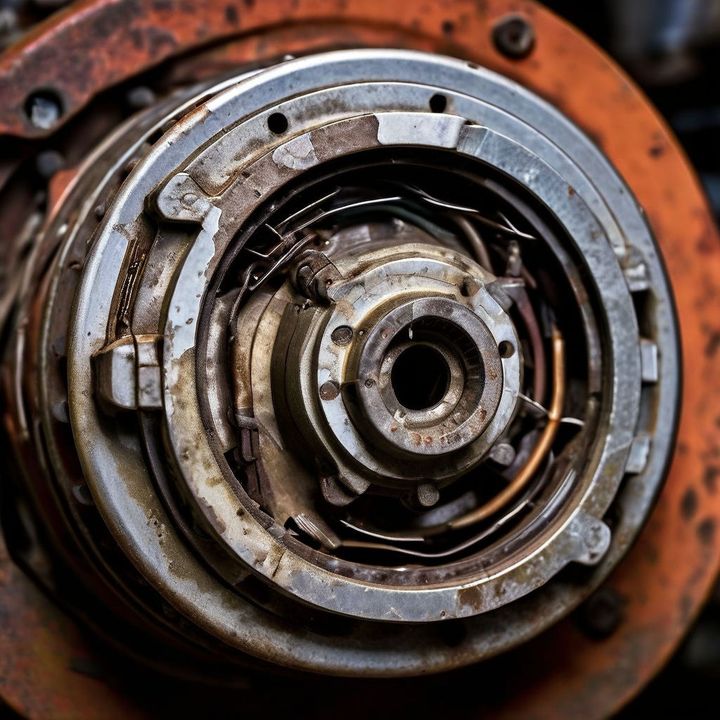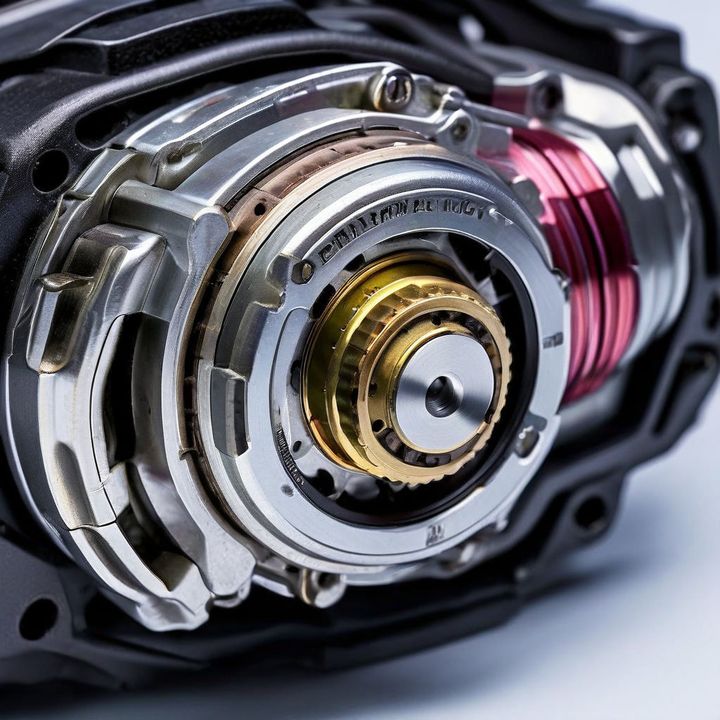


The air conditioning (AC) compressor clutch is a crucial component in a vehicle's air conditioning system. It is responsible for engaging and disengaging the compressor from the engine's rotational power source, typically the crankshaft pulley. The clutch plays a vital role in ensuring efficient cooling and optimizing the system's overall performance.

Let's explore the main culprits behind AC compressor clutch failure:
| Cause | Description |
|---|---|
| Low Refrigerant Levels | Refrigerant not only keeps your cabin cool but also acts as a lubricant for the compressor. When the refrigerant level drops due to leaks in the system, the compressor's internal components can experience excessive wear and tear, eventually leading to clutch failure. |
| Electrical Issues | The AC compressor clutch is an electromechanical component, and electrical problems can prevent it from engaging or disengaging properly. Common issues include a failed clutch coil, faulty wiring, blown fuses, or malfunctioning control modules. |
| Contamination | Moisture or debris entering the AC system can mix with the refrigerant and lubricant, causing corrosion, sludge buildup, and premature wear. This contamination can lead to clutch slippage, improper engagement, and ultimately, clutch failure. |
| Mechanical Problems | Worn bearings, seized pulleys, or excessive clearance between the clutch plate and pulley can cause the clutch to slip or disengage improperly. These mechanical problems can be caused by age, lack of maintenance, or manufacturing defects. |
| Overheating | Blocked condenser fins, failed cooling fans, or excessive high-pressure conditions within the AC system can cause the compressor to overheat, leading to premature wear and eventual clutch failure. |
As a mechanic, diagnosing AC compressor clutch issues is a crucial step in addressing the problem. Here are some diagnostic steps I typically follow:
With the engine running and the AC turned on, I visually inspect the clutch to see if it's engaging and disengaging properly. The clutch plate should spin with the pulley when the AC is on, and stop spinning when the AC is turned off. I also listen for any clicking sounds that may indicate engagement or disengagement issues.
Unusual noises coming from the compressor area can be a telltale sign of clutch problems. Grinding, squealing, or rattling noises may indicate bearing failure or clutch slippage. I always pay close attention to any abnormal sounds during the diagnostic process.

Using a feeler gauge, I check the air gap between the clutch plate and the pulley. An excessive gap can prevent proper engagement, while a gap that's too small can cause the clutch to drag and wear prematurely. Adjusting the air gap to the manufacturer's specifications is crucial for proper clutch operation.
| Acceptable Air Gap Range | Potential Issues |
|---|---|
| Within Specification | Proper clutch engagement and disengagement |
| Excessive Gap | Clutch may not engage properly |
| Insufficient Gap | Clutch may drag and wear prematurely |
To diagnose electrical issues, I test the resistance across the clutch coil terminals using a multimeter. If the resistance readings are out of specification, it's a clear indication that the clutch coil needs to be replaced.
| Resistance Reading | Interpretation |
|---|---|
| Within Specification | Clutch coil is functioning properly |
| Out of Specification | Clutch coil needs to be replaced |
Low refrigerant levels can often be traced back to leaks in the AC system. I carefully inspect the entire system for signs of leaks, such as oil residue or UV dye traces. Identifying and repairing these leaks is essential to restore proper refrigerant levels and prevent further clutch damage.
Common leak locations:
Hose connections
Compressor shaft seal
Evaporator core
Condenser core
Once the root cause of the clutch failure has been identified, it's time to tackle the repair. Here are some common repair procedures I follow:
If a refrigerant leak is detected, I locate and repair the leak, evacuate the system, and recharge it with the correct amount of refrigerant. This ensures that the compressor has the proper lubrication and prevents further clutch wear.
If the clutch coil resistance test indicates a faulty coil, I replace it with a new one. This simple repair can often resolve electrical issues and restore proper clutch engagement.
In cases where the clutch plate, bearings, or pulley are worn or damaged beyond repair, I replace the entire clutch assembly. This is a more involved repair, but it ensures that all the components are in good working condition.
If the clutch air gap is out of specification, I follow the manufacturer's procedure to adjust it using shims or other methods. Proper air gap adjustment is crucial for smooth clutch operation and longevity.
When contamination is the culprit, I flush the entire AC system and replace any contaminated components, such as the receiver/drier or expansion valve. This ensures that the system is clean and free of debris or moisture that could cause further damage.
Common contaminated components:
Receiver/drier
Expansion valve
Evaporator core
If overheating is the issue, I address the root cause, whether it's blocked condenser fins, failed cooling fans, or refrigerant overcharge. Resolving the overheating problem is essential to prevent further damage to the compressor and clutch components.
Potential overheating causes:
Blocked condenser fins
Failed cooling fans
Refrigerant overcharge
Prevention is always better than cure, and maintaining the AC compressor clutch is crucial to avoid costly repairs down the line. Here are some tips I recommend:
Perform periodic visual inspections of the AC system and check for proper operation. Catching issues early can prevent more significant problems from developing and save you money in the long run.
Recommended inspection intervals:
Every 12 months or 12,000 miles (whichever comes first)
Before and after summer season
Always use the correct refrigerant type and compressor oil specified by the manufacturer. Using the wrong refrigerant or lubricant can lead to compatibility issues and premature wear.
Common refrigerant types:
R-134a
R-1234yf
R-12 (older vehicles)
Avoid running the AC system continuously for extended periods, as this can lead to overheating and excessive strain on the compressor and clutch components.
Recommended AC usage:
Run the AC for short periods (15-20 minutes) at a time
Allow the system to cool down between cycles
If you notice any worn bearings, pulleys, or other mechanical components during inspections, replace them promptly. Addressing these issues early can prevent further damage and extend the life of your AC system.
Common worn components:
Bearings
Pulleys
Belts
Hoses
The cost of repairing an AC compressor clutch can vary significantly depending on the specific issue and the extent of the repair required. Here are some general cost estimates:
| Repair | Estimated Cost Range |
|---|---|
| Clutch coil replacement | $100 - $300 |
| Clutch assembly replacement | $200 - $500 |
| Compressor replacement (if required) | $500 - $1,000 |
| Refrigerant leak repair | $100 - $500 (depending on the location and severity of the leak) |
| Labor costs | $100 - $300 (for diagnosis and repair work) |
It's important to note that these costs are rough estimates and can vary based on factors such as the make and model of your vehicle, the availability of parts, and the labor rates in your area. In some cases, it may be more cost-effective to replace the entire AC compressor rather than attempting to repair individual components, especially if the compressor is nearing the end of its expected service life.
As a mechanic, I've seen firsthand the frustration and discomfort that AC compressor clutch failure can cause. However, by understanding the common causes, properly diagnosing the issue, and following the appropriate repair procedures, you can get your vehicle's AC system back in top shape.
Remember, regular maintenance and inspections are key to preventing clutch failure and extending the life of your AC system. Don't hesitate to seek professional assistance if you're unsure about any aspect of the diagnosis or repair process.
Stay cool out there, and happy motoring!
Refrigerant leaks are the primary cause of low refrigerant levels. These leaks can occur due to worn seals, damaged hoses, or other issues in the AC system.
When refrigerant levels are low, the compressor has to work harder to circulate the remaining refrigerant, leading to excessive wear and potential clutch failure.
Common signs include the clutch not engaging or disengaging properly, clicking or whining noises, and a blown fuse or relay related to the AC system.
Yes, if the clutch is stuck in the engaged position, the compressor will run continuously, leading to potential overheating and damage.
The clutch air gap is the space between the clutch plate and the pulley. Maintaining the proper gap is crucial for smooth engagement and disengagement of the clutch.
Moisture or debris entering the AC system can mix with the refrigerant and lubricant, causing corrosion, sludge buildup, and premature wear of the clutch components.
The low-pressure switch monitors the refrigerant pressure and prevents the compressor clutch from engaging if the pressure is too low, protecting the compressor from damage.
Yes, a slipping or damaged drive belt can cause the compressor pulley to spin erratically, leading to excessive wear and potential clutch failure.
Regular maintenance, including inspections and servicing, can help identify potential issues early and prevent costly repairs or replacements of components like the compressor clutch.
Overcharging the system with too much refrigerant can lead to high-pressure conditions, causing the clutch to disengage or potentially fail due to excessive strain.

Sarah isn't your average gearhead. With a double major in Mechanical Engineering and Automotive Technology, she dived straight into the world of car repair. After 15 years of turning wrenches at dealerships and independent shops, Sarah joined MICDOT to share her expertise and passion for making cars run like new. Her in-depth knowledge and knack for explaining complex issues in simple terms make her a valuable asset to our team.













